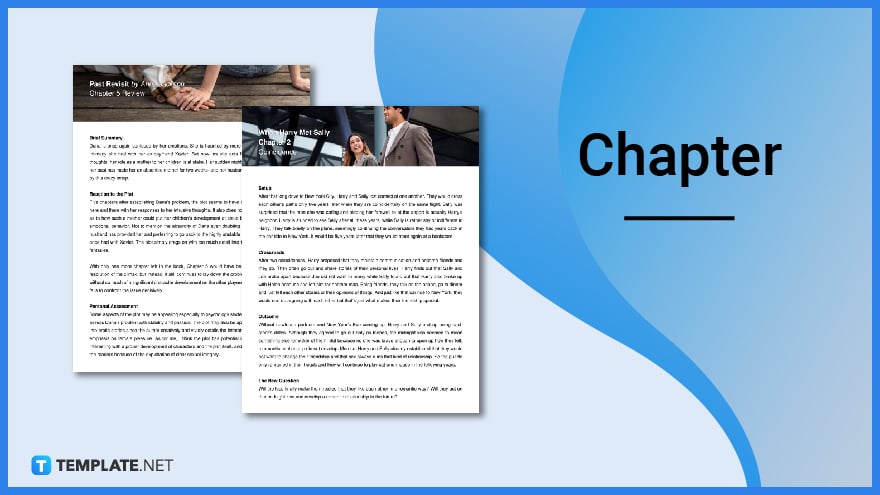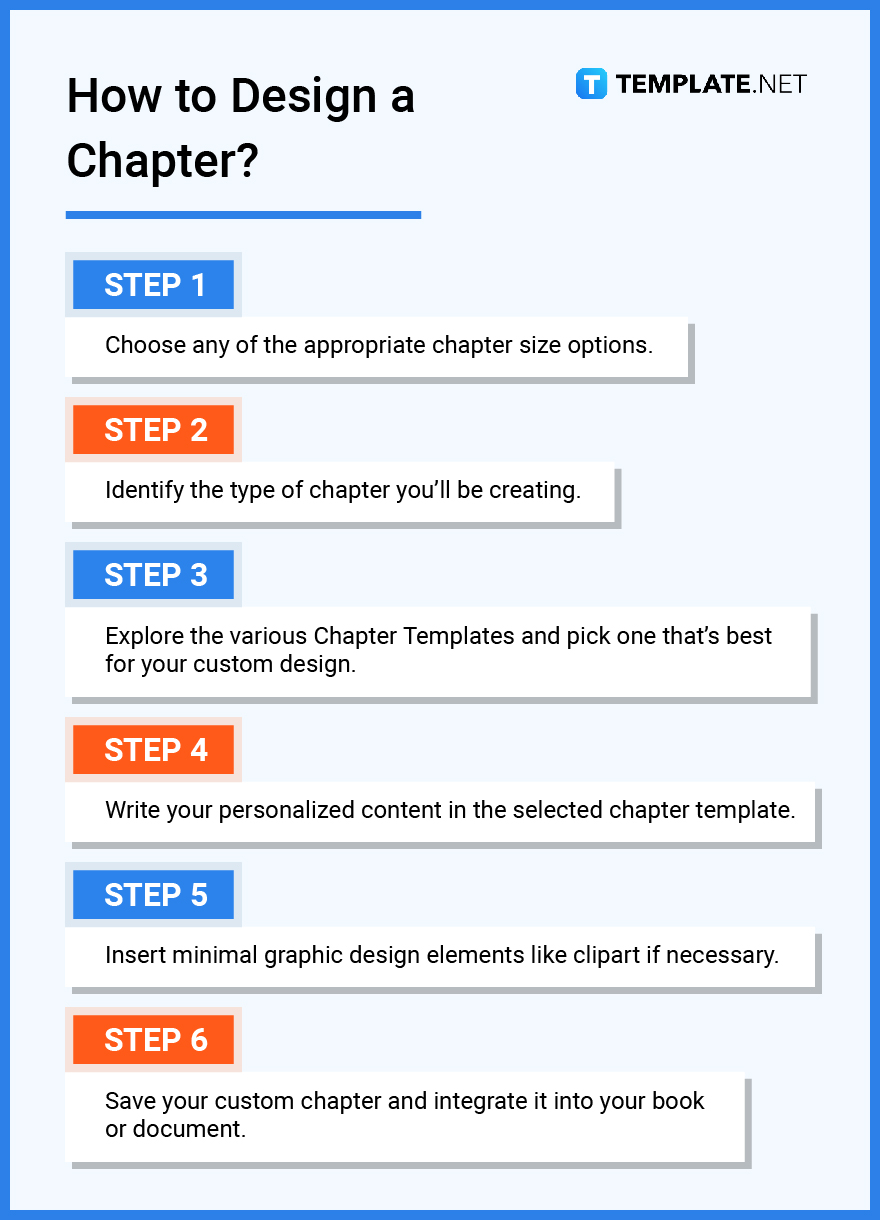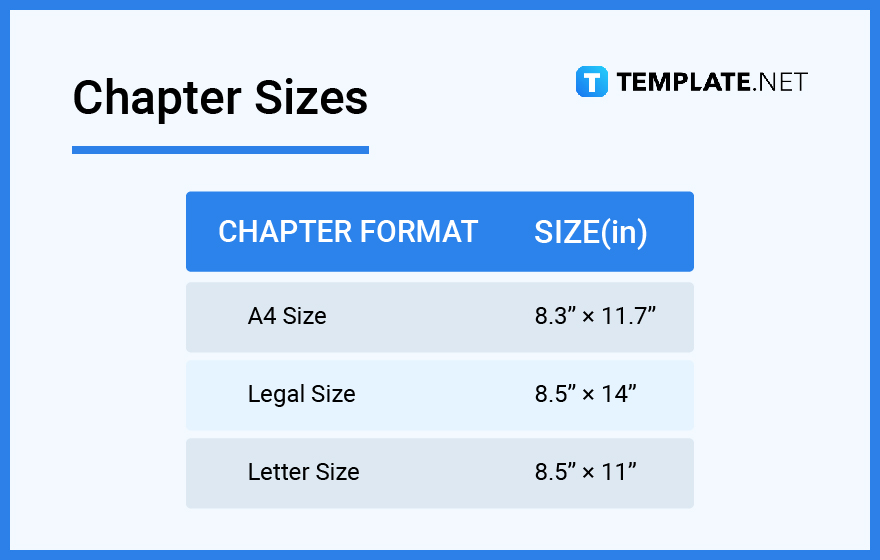![How To Create Meeting Minutes in Google Docs [Template + Example]](https://images.template.net/wp-content/uploads/2023/07/How-To-Make_Create-Meeting-Minutes-in-Google-Docs-Template-Example-788x443.png)
How To Create Meeting Minutes in Google Docs [Template + Example]
Meeting minutes Play a vital role in the recording of meeting information and details. In any kind of meeting, there is always…
Mar 10, 2023
Chapters are always present in books, documents, thesis papers, and other types of long-form literature you can name. They’re what make these literary works whole, keep the readers interested, and feed vital information to provide a clear, complete context.

A chapter is a particular section in a document or a book that’s numbered or has its own title and focuses on a particular subtopic or subplot that ties in with the overarching content of a literary piece.
Chapters are divisions of books and various forms of documents like contracts and business plan templates with multiple pages that discuss or narrate a certain element of the topic/story.
A chapter is a significant part of a long-form document or a book’s writing since it helps establish the foundation of a story/topic and complements the overview of a literary work’s content. It can have one page or multiple pages depending on the scope of its subtopic/subplot that’s imperative to the organization of a book or document’s written information. A chapter may focus on a particular sequence of events or records that support the literary piece’s claims or overall narrative.
Scene chapters are chapters in a book that narrate particular scenes that are happening in the story. Some of them tell the scenes in a form of a montage and some are written in a way that the scenes are happening in real-time. Scene chapters are engaging to read because they move a novel’s plot forward and keep the readers interested.
As its name suggests, a chapter summary is a type of chapter that summarizes the events in a story or in a particular chapter. It sort of provides a quick recap of what happened so the readers can easily connect to the events of the next chapter. With that in mind, chapter summaries are often written with brevity and conciseness.
A chapter list novel shows a complete list of all the chapters of a novel—kind of like a table of content. Each chapter title or chapter number that’s listed is accompanied by a synopsis of the chapter’s events so the readers will know what to expect. The synopsis doesn’t paint a complete picture of what the chapter is about but it gives a clear preview that stimulates curiosity.
Chapter notes provide detailed information about the discussion or agreements in a formal document like a company policy, management policy, administrative business contract, bankruptcy statement, investment proposal, and more.
A chapter review is a kind of chapter that basically provides a quick summary of the chapter’s story and outlines the reader’s feedback or reaction to it. Chapter reviews are either written with an objective or subjective voice and sometimes a mix of both. The readers will share their opinions and criticisms about the chapter and will talk about what they’ve learned or discovered in its contents.
A 2-page chapter is often found in business documents, corporate documents, budget documents, and other types of formal documents that concern legal information or business-related data. The space of a 2-page chapter is enough to accommodate tables with statistics and written content that contributes to the context of the document. Chapters like this are critical to settling legal arrangements, business programs, schedules, service orders, insurance settlements, and more.
A book chapter summary summarizes the sequence of events that occurred in a particular chapter/part of a book. It allows readers to look back at what happened without rereading the entire chapter all over again. It essentially functions as a quick recap section before a reader moves on to the book’s next chapter.
Chapter proposals are sections of a proposal document that support its goals and advocacies. They contain information that convinces their target readers to approve the proposal or at least contribute to its fruition. The proposal can be about opening a restaurant business, launching a project that benefits society, investing in a company, building online awareness campaigns, and other significant movements that usually involve money, large assets, and manpower.
A chapter book cover is essentially the same as a book cover but it functions as a cover for a specific chapter, not for an entire book. Its design is typically sprinkled with artistic illustrations and cartoon clipart that are full of colors; it may also display the logo of the book’s publisher. The aesthetics of a chapter book cover subtly previews what events and themes to expect in the chapter.
A chapter charter is a statement in a charter document that explains the purpose and importance of establishing a new department or branch in an organization. It’s written with a firm and convincing voice which helps bring the message with an impact.
Chapters are present in books and documents for good reasons. They’re not filler content just to make the literary piece look impressive and thick, giving the impression that it’s written with the tiniest details in mind.
Chapters allow writers to highlight the importance of a subtopic or subplot in their literary masterpieces. With each chapter, they can let their readers explore the various aspects of their story and how they contribute to the manifestation of the overall narrative. Chapters also let writers cover multiple points of view to provide a better context of everything that’s happening.
Even the most avid readers don’t have all the time in the world to read literary works nonstop; that’s among the reasons why books and long documents have chapters. Readers can use the chapters as markers to take a break for a time and pick up right where they left off easily later on when they’re free to continue reading. Books without chapters are quite exhausting to read, and it would be hard for the readers to identify which part of the book they can take a pause in.
Dividing their literary works into multiple chapters enable writers to better organize their writing. They’re able to dictate the pacing of their content and build a better structure for their narrative. Chapters help build momentum leading up to the climax and leave readers satisfied when they’re finished reading.
Books and other literary works that are partitioned into chapters are easy to revisit, especially for readers who habitually reread their favorite parts or lines on the pages. Other than that, chapters make it easier for critics and casual readers to create detailed reviews breaking down their thoughts and options of the literary piece.
The chapter title or the chapter should be found on the header part of the chapter’s page. It must be written in a large font style for emphasis. It can also have a fancy font style that matches the font of the book title on the book cover.
The header where the chapter title/chapter number is displayed can have a well-designed background. The background can be an image that relates to the story/narrative or a plain simple color.
The chapter content is the main body of a chapter and it can span a single page or most likely multiple pages. The content is divided into paragraphs for better readability and organization of the writer’s thoughts.

1. Choose any of the appropriate chapter size options.
2. Identify the type of chapter you’ll be creating.
3. Explore the various Chapter Templates and pick one that’s best for your custom design.
4. Write your personalized content in the selected chapter template.
5. Insert minimal graphic design elements like clipart if necessary.
6. Save your custom chapter and integrate it into your book or document.

A chapter is a division of a document or a book that focuses on a particular subject of a topic/lesson or particular events in an overarching story.
A journal is a record of events and outcomes that a person has experienced and details his/her thoughts, feelings, and opinions about them; it’s a lot like a diary but more in-depth.
A chapter is a specific section in a document or book with its own subtopic or subplot that’s imperative to the overall focus and narrative of the literary work.
An article is a piece of written content typically found in magazines, newspapers, and websites that cover trending topics and talks about them with the support of facts and other credible sources.
A research paper is an academic or scientific literary piece that details the methods, the process, and other supporting factors that prove the credibility of a researcher’s findings.
Chapters also have standard sizes for printing just like books and documents. Technical writers and book authors must always take note of the best chapter size options.

Even the best writers get burnt out due to the numerous hours that they’ve been writing engaging content. To rejuvenate their creativity, many of them explore various chapter ideas in order to gain inspiration.
A chapter must contain detailed descriptions of what’s happening in the story and must have content that pushes the narrative forward; in other words, it needs to have a goal, and that goal is to keep the readers invested.
In research papers, every chapter must strictly have content that’s relevant to the research and should include citations to support the claims and findings.
In books, chapters are typically divided into sections that focus on a particular subtopic; chapters partitioned in that way are very common in long literary works such as history books.
A dissertation’s introduction chapter must present the central questions and goals of the research, the review chapter must have an assessment of the research’s questions, and the results/methodology/discussion chapter must undertake the new research.
Chapter titles are written in books with larger font styles; some of them have a unique title while some are simply numbered like “Chapter I,” “Chapter II,” “Chapter III,” “Chapter IV,” and so on.
A chapter breakdown is basically a detailed summary or review of the contents of a specific chapter; chapter breakdowns are created by the readers or critics where they share their key takeaways and opinions about the chapter.
A good first chapter establishes the theme and the goal of a story; it also lays out the foundation for how a character’s arc would develop throughout the narrative, particularly the main character.
The breaks in a chapter are indicators that a scene has ended and the narration is about to transition to the next scene.
The standard of most published books is that a chapter must start one-third to halfway down a book’s page.
It has long been a basic rule that a chapter must always start on the right-hand page of a book; if the previous chapter ended on a right-hand page, the next chapter shouldn’t start on the next left-hand page so it must be left blank and the writer must proceed to the next right-hand page.
![How To Create Meeting Minutes in Google Docs [Template + Example]](https://images.template.net/wp-content/uploads/2023/07/How-To-Make_Create-Meeting-Minutes-in-Google-Docs-Template-Example-788x443.png)
Meeting minutes Play a vital role in the recording of meeting information and details. In any kind of meeting, there is always…
![How To Make/Create a Manual in Google Docs [Templates + Examples] 2023](https://images.template.net/wp-content/uploads/2023/07/How-To-Make-Create-a-Manual-in-Google-Docs-788x443.png)
Manuals are essential instructional and reference guides. They help direct and inform an individual’s actions and also explain how to…
![How To Make/Create a Manual in Microsoft Word [Templates + Examples] 2023](https://images.template.net/wp-content/uploads/2023/07/How-To-Make-Create-a-Manual-in-Microsoft-Word-788x443.png)
Creating a manual can be a time-consuming and tedious task. However, manuals and other reference guides are necessary for organizations…
![How To Create a Legal Document in Google Docs [Template + Example]](https://images.template.net/wp-content/uploads/2023/07/How-To-Make_Create-a-Legal-Document-in-Google-Docs-Template-Example-2023-788x443.png)
When creating a legal document, there are a lot of things a person has to consider, and one of which is the…
![How To Make/Create a Contract in Microsoft Word [Template + Example] 2023](https://images.template.net/wp-content/uploads/2023/07/How-To-Make_Create-a-Contract-in-Microsoft-Word-Template-Example-2023-1-788x443.png)
Contracts can come in different forms and for different reasons but the most common thing is that when a company does business with…
![How To Create a Contract in Google Docs [Template + Example]](https://images.template.net/wp-content/uploads/2023/07/How-To-Make_Create-a-Contract-in-Google-Docs-Template-Example-2023-Step-788x443.png)
Contracts are an important part of any company or business, especially those that work with different companies or businesses. Companies…
![How To Make/Create a Report in Google Docs [Templates + Examples] 2023](https://images.template.net/wp-content/uploads/2023/07/How-To-Create-a-Report-in-Microsoft-Word-788x443.png)
A report is a comprehensive document that covers a wide array of topics from finance, research, incidents, feasibility studies, and…
![How To Make/Create a Report in Microsoft Word [Templates + Examples] 2023](https://images.template.net/wp-content/uploads/2023/07/How-To-Make_Create-a-Report-in-Microsoft-Word-Templates-Examples-20232-788x443.png)
A report is a document that contains information, data, analysis, finding, and other relevant information based on a specific topic.…
![How to Make/Create a Notebook in Google Docs [Templates + Examples] 2023](https://images.template.net/wp-content/uploads/2023/07/How-to-Make_Create-a-Notebook-in-Google-Docs-Templates-Examples-2023-788x443.png)
Notebooks always come in handy in writing important information or expressing our thoughts through written words. When we need a…